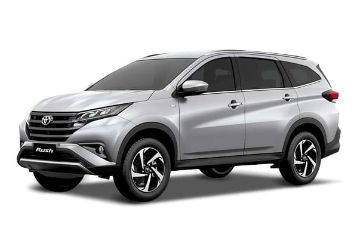![Which One is Better: Toyota Rush or Its Rivals? 01]()
(Images from Toyota PH)
The Toyota Rush is a seven-seater SUV, with a ground clearance of 220mm. It has a 4 Cylinder, In-line, 16 Valve DOHC, Chain Drive with Dual VVT-I engine, which has a power output of 102 horsepower and 134 Newton meters of torque. Its engine is paired with either a manual transmission or an automatic. Released in 2018, the Toyota Rush was seen as a mini version of the best-selling Toyota Fortuner, and the latter’s success was almost rubbed on it. Soon, the Rush became a mainstay on Philippine roads.
![Which One is Better: Toyota Rush or Its Rivals? 02]()
But 2018 is quite a long time ago, even pre-dating the pandemic which became a game changer in how people see the world and how people think. Many car releases after, one may prod the question, is the Toyota Rush still something worth buying?
Today we will try to answer this question by comparing the Rush to some of its closest competitors and try to come up with a verdict at the end, sort of.
![Which One is Better: Toyota Rush or Its Rivals? 01]()
To start off, let’s talk about the engine of the Rush. Compared with the Honda BR-V which has an output of 120 HP and 145 Nm of torque, and with the Xpander which has a 105 HP and 141 Nm output, the Rush is seen as underpowered, but hey, power is not just about the number of HPs. It’s about how that power is distributed to the weight too, but hey, the Rush is quite underpowered. As an SUV and it shares an engine with an Avanza and a feisty, new Veloz, it seems that the Rush is a redundancy or an old model. The edge of the Rush, even to the BR-V and Expander, however, is its rear-wheel drive. This gives the Rush better handling and a little more push despite the numerical difference in power output.
![Which One is Better: Toyota Rush or Its Rivals? 02]()
Of course, the Rush is now a 7-seater despite all variants (before the E MT and AT were just 5-seaters), just like its competitors. More than this, the BR-V and the Xpander seems like an iteration of the Rush in a different brand – same safety features, same seat material, almost the same features in the infotainment system, same multi-info display. The difference comes with the number of speakers where the Rush G variant dominates with eight, to the Xpander’s six and the BRV’s four. Also, in terms of ride height, the Rush dominates with 220mm versus the other two’s 201mm and 205mm. The Rush also comes with a back camera and sensors while the others may only have either.
![Which One is Better: Toyota Rush or Its Rivals? 03]()
![Which One is Better: Toyota Rush or Its Rivals? 04]()
![Which One is Better: Toyota Rush or Its Rivals? 05]()
To end, it seems like the Rush is still edging its competition in small ways. The real competition of the Rush perhaps does not come outside the Toyota dealership but from within. The Veloz and the facelifted Avanza may come as opponents one and two. The Veloz shares almost the same price as the Rush but it offers newer features that could be minute but so convenient like Android Auto and Apple CarPlay. If you’re superficial, the looks of the Veloz are more aggressive, sleeker and more modern. Perhaps if the Rush gets a facelift, then we can compare it once more.
So, to answer our predicament, yes, some people will still prefer the Rush with its unique features, but if I were you, you may also look into other cars in its price point and segment. Remember, only fools rush in.











